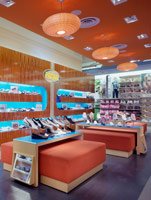Top California Design Firm Gensler Shows Face in Home State
Gensler is the name of one of the biggest design firms in the United States, but Californians may just be getting re-acquainted with the San Francisco–headquartered company over the past 12 months. Some of the firm’s high-profile retail clients are on the cusp of unveiling or have recently debuted store concepts that were designed by Gensler.
In April, Pacific Sunwear will roll out the first few doors of its highly anticipated footwear chain One Thousand Steps. Gensler worked with Pacific Sunwear on the footwear chain’s look as well as on the redesign for its prototype store at the Galleria at Tyler in Riverside, Calif. (See related story here.) The Pacific Sunwear redesign bowed in July 2005.
If The Gap seems familiar to almost every mall shopper, they can thank Gensler, which worked on one of the first looks for the retailer in 1974. The company was called in to work on the recent redesign of Gap stores, which has been judged as crucial to returning the retailer to the widespread popularity it enjoyed a few years ago. The redesign debuted at seven Colorado locations in April 2005. It made its California debut at San Diego malls Fashion Valley and Horton Plaza in the fall of 2005.
Neiman Marcus is another client. Gensler designers worked on the renovation of three departments on the third floor and the children’s store at the Neiman Marcus location in Beverly Hills, completed in February, as well as on the remodeling of Neiman Marcus’ Houston store, which is scheduled to be completed in April.
Last year, the firm designed Forever 21’s San Francisco flagship, based in the city’s ornate Bank of America building, and also has a contract to redesign Toyota dealerships across the United States. Such high-profile clients have helped the firm already surpass its forecast of earning $400 million for the 2005–2006 fiscal year, according to a Gensler representative, who said that 15 percent of the company’s projects are for retailers.
Gensler’s success is indicative of a trend within the retail industry. Retail designers are commanding bigger paydays, according to a March 2006 survey published by Display & Design Ideas magazine, which is owned by media conglomerate VNU Business Media Inc. The survey noted that the top 100 design firms reported a 27 percent increase in revenue in 2005. The top-10 firms reported a 39 percent increase in revenue. Gensler was listed as the second biggest design firm ranked by revenue. The top firm was Seattle-based Callison.
Gensler’s size influences a lot of its success, said Russell Sway, president of the Institute of Store Planners, an international professional association of store designers. “They get a lot of work because they are big,” Sway said. “People know them, and they’re good at what they do. On a given day they can be great. To their credit, they were one of the first big, general architectural firms to recognize the importance of retail.”
While Gensler has worked on retail projects since its origin in 1965, the firm also started the San Francisco–based Gensler Studio 585, which specializes in retail, said Michael Bodziner, a principal at Gensler. “It gave us publicity for more retail design practice. We’d heard from clients that they didn’t realize Gensler designed retail,” Bodziner said.
One aspect of a successful redesign happens to be finding new dimensions on projects. The multi-million-dollar retailers who commission the projects typically have welldeveloped ideas on the look of their stores.
It’s a collaborative job, said Jeff Henry, another Studio 585 principal. “Our clients are really smart. They know their business and their brand well. Our job is to interpret that into an experiential environment,” Henry said.
In the case of redesigning the Pacific Sunwear store, Ted Jacobs, a Studio 585 design director, said his firm was challenged to create a design that would speak to every Pacific Sunwear customer. The firm also had to find a store design that would call attention to every brand the retailer offers without allowing one to dominate another.
“We designed for authenticity.” Jacobs said. “It would be evocative of lifestyles, but the store would not mimic it. We would not hang surfboards from the ceilings.”
Instead, many of the architectural shapes in the redesigned store vaguely look like waves or a skateboard ramp. The entryway doors were constructed of koa, the Hawaiian wood from which surfboards were first made.
Inside, brands were organized clearly by category, such as footwear, denim or T-shirts. Jacobs said the new look refreshed the store’s ambiance and gave regular shoppers a sense of discovery about Pacific Sunwear. “We had kids come into the store and say, ’I didn’t know that you carried that stuff,’ ” he said, noting that Pacific Sunwear had not changed its merchandise mix.























